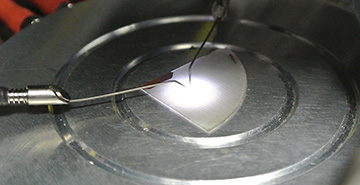
Monolithic LEDs emit a natural-white light without using phosphors. [Image: © 2020 KAUST]
The Nobel Prize-winning invention of the blue LED in 1992 sparked a lighting revolution by allowing for the creation of white LED bulbs. Commercial white LEDs use a phosphor conversion layer in combination with a blue LED to achieve white-light emission. However, the conversion process results in efficiency losses, and phosphor also degrades over time, which limits the lifetime of the bulb.
In a new study, researchers at King Abdullah University of Science and Technology (KAUST), Saudi Arabia, demonstrate a phosphor-free white LED that can be tuned from warm white to cool white emission (Appl. Phys. Lett., doi: 10.1063/5.0026017). While its efficiency remains limited and more work is still needed, the device represents a step toward the development of practical, phosphor-free white-light sources.
Combining colors to create white light
Traditional white LEDs are fabricated by coating a blue LED with a phosphor. A proportion of the blue light is absorbed by the phosphor and converted to another color. The mixture of different colors results in what our eyes perceive as white light.
Previous work has attempted to create white LEDs without phosphor by growing layers of compound semiconductors with different emission wavelengths to form a single structure. These devices have been plagued by a poor color rendering index (CRI), which indicates how naturally the colors of objects appear with a given light source, due to a lack of red emission.
Kazuhiro Ohkawa, professor of electrical and computer engineering at KAUST, and his colleagues recently developed a red LED by growing specifically designed indium gallium nitride (InGaN). They were able to leverage the same technologies to invent a new type of white LED, based on integrated InGaN quantum wells, that would have more widespread uses than its red counterpart.
“Our motivation is to realize a new impact on the field of white LEDs based on our InGaN-based red LEDs,” said study author Ohkawa. “The white LED is an application of our red LEDs, and the market size of white LEDs is very large compared to those of colored LEDs.”
Achieving a high color rendering index

KAUST Research Scientist Daisuke Iida produces a white-light LED. [Image: © 2020 KAUST]
The researchers employed metal-organic vapor-phase epitaxy to grow the LED structures, which contained a blue single-quantum well and red double-quantum wells, on a sapphire substrate. Scanning electron microscopy revealed several material defects—pits with a V-shaped cross-section—on the LED surface, which actually serve to significantly improve hole injection into the blue and red quantum wells.
Testing of the fabricated LED devices demonstrated a high CRI value of 88 out of 100 at an injection current of 10 mA, which can be attributed to the red emission component. Typically, lights with a measured CRI greater than 80 are considered acceptable for most applications.
“Our white LEDs emit in the range from 410 nm to 770 nm, which is almost identical to human eye sensitivity,” said Ohkawa. “Our range is the widest one compared to other monolithic white LEDs and most of the white LEDs with phosphor.”
In terms of future research, Ohkawa and his colleagues hope to realize higher efficiency for their red LEDs, since they also contribute to the limited efficiency of their white LEDs.
